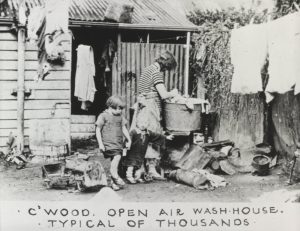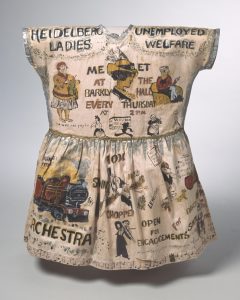26 Listening to marginalised Australian voices during World War I and the Inter-war period by Alex Elliot
1 . Policies and practices of racial exclusion in Australia during World War I and the inter-war period

Image of title page of Immigration Restriction Act 1901 Commonwealth of Australia (National Archives of Australia) (Public Domain)
| Curriculum context | VCE Unit 1 Modern History, Area of Study 1 (VCAA, 2020) |
| Historical context | World War I 1914 – 1917; Immigration Restriction Act and Racial Enlistment Exclusions |
| Historical thinking concepts | Continuity and change
Use of primary sources as evidence Taking historical perspectives Consider the “moral dimensions” or implications of the primary sources provided (Sharp et al., 2021, p.33). |
| Learning intentions | Students will build substantive knowledge of racially discriminatory policies during World War I with the intention of exploring historical ideologies, continuity and change and understanding different historical perspectives.
Students will also develop procedural knowledge through honing source analysis skills and literacy skills through answering the attached questions. |
Activity
In the following source analysis activity you are provided with several primary sources which relate to racially discriminatory policies affecting immigration and military enlistment in World War I. In response to this collection you are prompted to answer questions relating to the experience and perspectives of First Nations and non-European Australians.
Historical sources
Source 1: Image of title page of Immigration Restriction Act 1901 © Commonwealth of Australia (National Archives of Australia) 2019.
Access source here (Immigration Restriction Act 1901 | naa.gov.au, 2010)
Source 2: Image of Page 45 and 46 of The Defence Act 1903,
Access source here (Australia & Australia. Army., 1903)
Source 3: Image and Transcription of Page 9 Article Excerpt “Aborigines In Camp”(April 11, 1916),
Access source here (The Age, 1916)
Source 4: Image of Military Order 200 1917 © Commonwealth of Australia (National Archives of Australia) 2019
Access source here (Military Board of Administration, 1917)
Source 5: Image of Australian Imperial Force Enlistment of Samuel Tong-Way 1917 © Commonwealth of Australia (National Archives of Australia) 2019
Access source here (Australian Imperial Force, Base Records Office, 1917)
Questions to guide analysis:
- What could motivate the creation of a European language dictation test, as described in the Immigration Restriction Act 1901?
- What does the Immigration Restriction Act 1901 reflect about Australian Society after federation?
- Does Source 2 reflect change or continuity in policy affecting non-European Australians?
- In Source 3 James Arden describes the other Aboriginal men in the Condah community as “true British citizens”. What does this statement reflect concerning Civil Rights, Imperialism and Australian National Identity?
- Is Source 3 a reliable record of James Arden and Richard King’s perspectives?
- Source 5 shows the enlistment record of Samuel Tong-Way. Why was Samuel originally restricted from the defence force?
- Source 4 is a Military order that repeals formerly existing policy denying non-European Australians enlistment in the army (see Source 2). Why would this policy have changed?
- Using all the evidence available in Sources 1 – 5, How did the policies and practices of the Australian government and military impact Non-European and First Nations Australians?
References
Australian Government. (2010). Immigration Restriction Act 1901. National Archives of Australia. [Online] Available: https://www.naa.gov.au/students-and-teachers/learning-resources/learning-resource-themes/society-and-culture/migration-and-multiculturalism/immigration-restriction-act-1901
Australian Imperial Force, Base Records Office. (1917). Chinese-Australian brothers enlist twice in World War I | naa.gov.au. National Archives of Australia. [Online] Available: https://www.naa.gov.au/students-and-teachers/learning-resources/learning-resource-themes/war/world-war-i/chinese-australian-brothers-enlist-twice-world-war-i
Australian Imperial Force, Base Records Office. (2005). Enlistment of Samuel Tong- Way 1917. National Archives of Australia.[Online] Available: https://www.naa.gov.au/students-and-teachers/learning-resources/learning-resource-themes/war/world-war-i/chinese-australian-brothers-enlist-twice-world-war-i
Australian Government. (2022, January 17). Defence Act 1903. The Defence Act 1903-19 : regulations (provisional) and instructions for universal training. [Online] Available: https://nla.gov.au/nla.obj-38379987/view?partId=nla.obj-38395359#page/n153/mode/1up
Military Board of Administration. (1917). Amendment to Military Orders allowing ‘half-castes’ to enlist | naa.gov.au. National Archives of Australia. [Online] Available: https://www.naa.gov.au/students-and-teachers/learning-resources/learning-resource-themes/war/world-war-i/amendment-military-orders-allowing-half-castes-enlist
Immigration Restriction Act 1901 | naa.gov.au. (2010). National Archives of Australia.[Online] Available: https://www.naa.gov.au/students-and-teachers/learning-resources/learning-resource-themes/society-and-culture/migration-and-multiculturalism/immigration-restriction-act-1901
VCAA. (2020). VCE Study Design: History 2022-2026. Victorian Curriculum And Assessment Authority. https://www.vcaa.vic.edu.au/curriculum/vce/vce-study-designs/history/Pages/index.aspx
2. Understanding the interwar period through primary sources

Melbourne Victoria Australia Shanty Slum 1930s State Library of Victoria Collection, Flickr (CC BY 2.0)
| Curriculum context | VCE Unit 1 Modern History, Area of Study 1 (VCAA, 2020) |
| Historical context | Interwar Period; specifically considering the experience of different societal groups after World War 1. |
| Historical thinking concept/s | Use primary sources as evidence
Taking historical perspectives |
| Learning intentions |
Engage in an exploration of the interwar period’s impact on different societal groups following World War 1.
By examining the “Heidelberg Dress” (National Museum of Australia, 1931.) and its symbolism in representing the Great Depression’s effects, students will analyse the imagery to understand the historical context. Working collaboratively , students will use provided primary sources to design cartoons or text decorations on dresses, reflecting the experiences of their assigned societal groups during the interwar period.
|
Activity
In this activity you are invited to view the Heidelberg Dress, a garment constructed for an eight-year-old girl as part of a competition in 1931 (National Museum of Australia, n.d.). The dress was sewn by Patricia’s mother and hand painted by her father in a bid to win the competition’s cash prize (National Museum of Australia, n.d.). The dress focuses on the Heidelberg Unemployment Bureau’s services as well as the family’s general experience of The Great Depression (National Museum of Australia, n.d.). Form pairs to discuss the imagery of the dress and reflect on what it tells us about families’ and unemployed persons’ experience of The Great Depression.
See source here or search for “Heidelberg Dress” if it does not open up.

Image of ‘Heidelberg Dress’ Copyright National Museum of Australia, CC BY-SA 4.0.
You will now be assigned activity groups and each group will create their own dress. You may using the following printed dress template or make a 3D dress out of butcher’s paper. Design cartoons or text based decorations that represent the experience of assigned societal groups after World War I. Each group will receive primary source/s to guide their exploration of life for their group in the interwar period in addition to independent group research of internet resources.
(Please note: a variation of this activity could involve cutting paper to form a wearable dress structure that can be decorated and presented as worn by each group member.)
Dress template:

Primary sources for each group:
Historical Sources
Aboriginal and Torres Strait Islander Peoples
Abridged Transcription of Page 2 Article Excerpt “Communist Party’s fight for Aborigines” (September 25, 1931), Out of Copyright status Free/ CC Public Domain access source here (The Workers’ Weekly, 1931:2)PROGRAM OF STRUGGLE AGAINST SLAVERY
Full Economic, Political and Social Rights
…NO POLITICAL RIGHT The Aborigines have no political, social, or economic rights, no right to have property; they are denied education, or to have schools of their own; intellectuals from among the Aborigines are not allowed to practice their professions; the tribal customs and arts are stifled; wages are not to be paid to Aboriginal workers excepting to the amount of 10/- per week, but the Government gets 5/- of this amount for the A.P.B., and no wages at all to be paid by holders of licences. Although subject to all the penalties of the capitalist criminal code in the courts of justice (?) Aborigines have no status therein, and their evidence is inadmissible in “mixed” cases. Police accusers have the right (and exercise it) to beat and even shoot the accused until they plead “guilty” to whatever crime the police desire to place upon them. …
STARVATION RATIONS In N.S.W. the scale of rations of Aborigines is 3/10 per week for adults and 1/10 for children—little more than half that granted to white workers— which is just part of the general drive against the aborigines to make their standard of living considerably lower than that for other unemployed workers, and is part of the drive to exterminate the race. Under the regime of the social fas-cist Labor governments, Federal and State, the victimisation and exploitation of the aborigines are intensified and repressive measures on the part of the police are encouraged…
Abridged Transcription of Page 8 Article Excerpt “AUSTRALIAN ABORIGINAL. PROGRESSIVE ASSOCIATION” (October 7, 1925), Out of Copyright status Free/ CC Public Domain access source here (Macleay Chronicle, 1925: 8)
ABORIGINAL. PROGRESSIVE ASSOCIATION. (Continued from Page 4).A telegram received from Mr. W Page, Manager of the Australian Nat-ives Association ran as follows: ‘Greetings, hopes for good results conference. Justice of claims undoubted. Abori-gines must be accorded full citizenship rights.’ The Women’s Auxiliary, formed wholly of coloured people, performed the task of seating 3 relays of delegates and representatives and managing the luncheon in a most creditable manner. In the matter of finances they were fine; every participant was reminded of the high cost of living by the Secretary of the Women’s Auxiliary with her collection plate in hand. …The people were joining up and trying to fit them-selves to become members of an asso-ciation with a progressive policy. The condition to which they had sunk under present conditions was deplor-able. Mrs. Hatton said she was quite sure that a small portion of land given to them in their own right, with the right to develop their homes and families along their own lines, would bring an element of self respect into their lives, which would be the first step towards their redemption. P… Mr. F W. Maynard, President of the Central Association Branch, gave a paper on the Registration of the Asso-ciation the work upon which he had been engaged for several months. He was loudly applauded as he spoke of his pleasure in being in Kempsey once more and also when he referred to the evident growth of the work.…The president then read the follow ing resolution which was received and carried unanimously: — “As it is the proud boast of Australia that every person born beneath the Southern Cross is born free, irrespective of origin, race, color, creed, religion or any other impediment we, the repre sentatives of the original people, in conference assembled, demand that we shall be accorded, the same full right, and privileges of citizenship as are enjoyed by all other sections of the community.” A petition to Parliament was read and signed asking that the two ob-jectives of the A.A.P.A be granted to the people. A long procession of Aboriginal people came to sign the petition, which was completed about 6 o’clock, when the session closed. On Sunday Mr. F. W. Maynard ad-dressed a large open air meeting at Greenhill. The interest of the peo-ple as they listened to the impassioned appeal of the colored preacher was re-markable. Mr. Maynard appealed to the colored people to rise out of the ashes of the past and of the bad habits, and turn to Christ for help to alter their conditions. Collections were taken up at every session to cover expenses of the Con-ference. It is noteworthy that so far the fi-nances of the A.A.P.A have almost all been raised by the efforts of the colored people.
Immigrants
Image of of Page 6 Article Excerpt “White Australia Policy” (August 27, 1929), Out of Copyright status Free/ CC Public Domain access source here (Queensland Times, 1929: 4)
Image of of Page 12 Article Excerpt “British Labor Conference” (February 5, 1926), Out of Copyright status Free/ CC Public Domain access source here (The Age, 1926: 12)
Women
Prime Minister James Scullin © Commonwealth of Australia (National Archives of Australia) 2019 can be reused under the CC-By licence Access source here (Lynch, 1930)
Image of of Page 2 Article Excerpt “Bachelor Women” (June 20, 1922), Out of Copyright status Free/ CC Public Domain Access source here (Daily Standard, 1922, 2)
References
The Age. (1916, April 11). ABORIGENES IN CAMP. The Age. [Online] Available: http://nla.gov.au/nla.news-article155083486
The Age. (1926, February 5). British Labor Conference. The Age, 12. [Online] Available: https://trove.nla.gov.au/newspaper/article/155788099?searchTerm=alien%20equal%20rights#
Daily Standard. (1922, June 20). Bachelor Women. Daily Standard, 2. [Online] Available: https://trove.nla.gov.au/newspaper/article/179017239?searchTerm=vida%20goldstein#
Lynch, L. (1930). Request for financial assistance for unemployed women, deserted wives and widows – letter to Prime Minister James Scullin | naa.gov.au. National Archives of Australia. [Online] Available: https://www.naa.gov.au/students-and-teachers/learning-resources/learning-resource-themes/society-and-culture/great-depression/request-financial-assistance-unemployed-women-deserted-wives-and-widows-letter-prime-minister-james-scullin
Macleay Chronicle. (1925, October 7). AUSTRALIAN ABORIGINAL PROGRESSIVE ASSOCIATION. Macleay Chronicle, 8. [Online] Available: https://trove.nla.gov.au/newspaper/rendition/nla.news-article174390965.txt
National Museum of Australia. (n.d.). Heidelberg Dress. National Museum of Australia. [Online] Available: https://collectionsearch.nma.gov.au/icons/piction/kaui2/index.html#/home?usr=CE&umo=45410087
Queensland Times. (1929, August 27). White Australia Policy. Queensland Times, 6. [Online] Available: https://trove.nla.gov.au/newspaper/article/118487335?searchTerm=white%20australia%20policy#
The Workers’ Weekly. (1931, September 25). Communist Party’s fight for Aborigines, The Workers’ Weekly, 2. [Online] Available: https://trove.nla.gov.au/newspaper/article/209418403#
VCAA. (2020). VCE Study Design: History 2022-2026. Victorian Curriculum and Assessment Authority. https://www.vcaa.vic.edu.au/curriculum/vce/vce-study-designs/history/Pages/index.aspx

